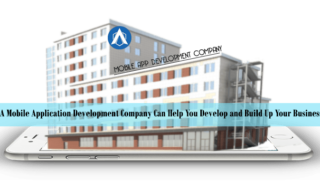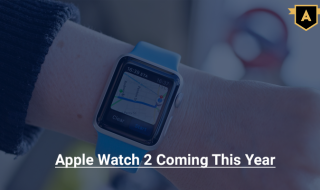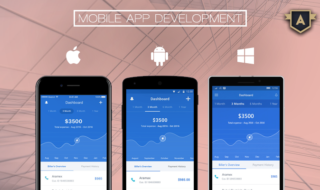
Mobile app development is a term used to denote the act or process by which a mobile app is developed for mobile devices, such as personal digital assistants, enterprise digital assistants or mobile phones. These applications can be pre-installed on phones during manufacturing platforms, or delivered as web applications using server-side or client-side processing (e.g., JavaScript) to provide an “application-like” experience within a Web browser. Application software developers also must consider a long array of screen sizes, hardware specifications, and configurations because of intense competition in mobile software and changes within each of the platforms. Mobile app development has been steadily growing, in revenues and jobs created.
Mobile application can in a variety of functionalities.There are a TON of moving parts at play, and every single one of them impacts the cost.The primary factors influencing development cost include:
- Business Model
- Platform
- Functionality
- Design
- developers
-
Business Model: What’s Needed?
The quest to build an android app or iphone app starts with your business plan and your business model for bringing in revenue. This model will be the most important driving force in the costs required to build your app.
When creating app, mobile application development companies USA and India are looking at your their plan and asking “What’s needed?”
- Where are our target customers spending their time?
- What devices and platforms are they using?
- How monetize the app?
- Will it be free to download?
- Will sell it for a fixed price?
- Will earn money via in-app purchases?
- Will app be used to advertise your own products or will 3rd party ads be a monetization method?
- Does audience care more about cutting edge visual design or practical functionality?
Each of these factors (and countless others) will determine what your app needs to become and thus, influence the amount you need to invest in platform access, functionality, design, and development.
For instance, it’s easier to create an app that is simply sold for a fixed, upfront price. In-app purchases, on the other hand, take longer to implement and are thus more expensive. And if you are wanting a full-blown ecommerce experience, you can expect to pay out even more.
What you need to connect with customers and bring in revenue will be the most important force behind the expense of your app.
-
Platform: Android vs Apple
Once you’ve determined what your app needs to do and who it need to reach, you will need to decide on a platform for its creation.
You can build an app accessible on a number of devices: iOS (iPhone and iPad), Android, Windows Phone, the Web or all together. And depending on which platform you choose, the price of its development will vary.
When we are talking about mobile apps however, for most businesses the options are either Android or Apple.
As a general rule, iOS apps are quicker and cheaper to build. On average, leading developers report Android apps requiring 2-3 times longer to develop than the same app in iOS. Apple also tends to have a more engaged, free-spending user base, which is why many companies opt to launch iOS-only apps initially and then expand to Android later if the iOS version proves to be successful.
That said, Android has gained significant ground over the last few years, and some developers no longer feel there is a significant difference between the two platforms. From a marketing perspective, Android has wider market penetration and reach, particularly in emerging markets.
At this point in app history, the intended audience of your app will probably have the most impact on your platform decision.
-
App Types & Functionality
Now that you’ve decided on the platform, it’s time to actually dive into building the app. The type of app you’re aiming to build and its technical specifications will be the single biggest factor in its cost.
Apps continue to become more and more dynamic, and there is virtually no limit to what can be produced. For the purposes of this guide, we’ve broken app types down into the following four categories:
Table/List
- Database
- Dynamic
- Games
Let’s take a close look at each type.
Table / List Based
These apps are designed primarily to display a relatively simple collection of information. In general, they present information to a user who can in turn select from available options and be redirected to additional materials on the topic. In other words, it functions very similarly to a simple, mobile-optimized website.
Database Based
These are more complex apps, designed to allow users to find, sort, and display data from very large data sets. Database apps often connect to a website or other online web service to retrieve information, making them more complex to develop than their Table based counterparts.
Dynamic Apps
These apps are similar to database apps, but instead of simply connecting to an online server for information, they need to cooperate with other platforms and software via APIs. For example, a 3rd party Twitter app would need to be integrated with Twitter’s API in order to import import tweets and other data. APIs vary in quality and complexity, so this addition to app development can range from a relatively small cost increase to a massively expensive undertaking.
Games
Lastly, the hardest app type to develop is that of app-based games. Simple games can be more on par with a dynamic app in terms of difficulty and pricing, but more complex games with 3D environments or advanced physics engines can be substantially more expensive than any other app type.
While these 4 categories do a good job of incorporating most app types and functionalities, apps these days are tremendously varied and hard to categorize.
The most important thing to understand is that every app’s unique functionality requirements will carry a corresponding cost. Some types of functionality might seem simple yet be very expensive to build, while other functionalities might be surprisingly affordable.
You won’t know for sure until you’ve actually solicited quotes from multiple developers.
-
Design: Average or High End?
When it comes to app development, the design can matter as much as the app’s functionality.
Customers buy with their eyes. A catchy icon can attract their attention. A breathtaking design makes them want to use the app more and more. (In fact, top rated iPhone app development companies USA create apps to be so visually pleasing.)
To look great, your app will need an icon, a splash screen, interface elements like tabs, buttons and many other design features that entice users to engage with it.
But a great design typically comes at a cost. While you can find winners and duds at any point in the prices spectrum, there is usually an obvious difference between a $300 icon and its $1,500 counterpart. If you want compelling design to work in your favor, you should be prepared to shell out some serious cash for a proven design team with an eye-catching portfolio.
At this point, it becomes a matter of budgeting and prioritizing based on your target audience. If your intended market is very design sensitive, it’s probably better to lower your ambitions in the functionality department and divert that money towards high end design. If your audience is far more UX or info driven, you will still want to ensure that your design is competitive with the market standard, but you don’t need to shell out for something cutting edge in the looks department.
-
Developer: Freelancer vs Agency
Everything we have described thus far has dealt with the app itself and how you want to create and market it.
The business model driving your decisions, the platform you choose, the functionality you need, and level of design your require are all baked in costs that can’t really be manipulated.
Let’s call these the “objective” costs of mobile app development.
Unfortunately, there is also a “subjective” side to app development costs, and this side deals with who you hire to design your app and what they charge.
There are 3 basic categories of developers you can choose from:
- Freelancer
- Small agency
- Large agency
There are a number of benefits and tradeoffs to each type of developer, let’s take a closer look at each one.
Freelancers
Freelance developers are typically the cheapest option you can find for developing an app, and really, their affordability is the ONLY reason you would hire a freelancer as opposed to an agency.
When you are hiring a freelancer, you are ultimately just hiring a person and all the risks that come with that. If the freelancer is unskilled, you could end up wasting your money. If the freelancer is slow, late, or uncommitted, your project could drag on indefinitely.
Furthermore, a freelancer will have a fairly limited range of expertise. It’s very rare for more complex apps to be successfully built by freelancers, and eve if your app is relatively simple, it’s unlikely you will find a single freelancer that can execute an entire app at a high level. If you go the freelance route, you will most likely need to hire a handful of freelancers, each of whom could cause problems and delays for your project.
There are fantastic freelancers out there, and if you can manage to find a few great ones, you can potentially get a great app made at a very low cost, but you are just as likely to end up with no app and no money.
Small Agencies
Small app agencies or top application development companies USA are typically a collection of 3-10 creatives focused on creating a specific class of app. Each member in the company is there to meet a specific need in the app creation process, allowing the agency to be a one-stop shop.
If you can find a small agency that builds apps in a similar category to what you are looking to build, you will benefit tremendously from their past experience. Having a best iPhone application development companies USA usually results in a greater degree of quality assurance, consistency, and timely delivery. And while they tend to be a good bit more expensive than freelancers, they still provide a tremendous cost savings as compared to large agencies.
On the downside, small agencies are often unequipped for highly complex apps and still have the potential to manifest the downfalls often associated with freelancers, although to a much lesser degree.
Top rated iphone application development companies USA as a whole provide a very attractive middle ground on price, quality, and consistency.
Big Agencies
Big app agencies bring large teams, heaps of experience, and a big brand guarantee to the table. Hire dedicated iPhone app developers USA to build your app is the closest you can get to a quality guarantee, but you will also be paying a significant premium for that assurance.
If your app is highly complex, a larger agency might be the only development option cable of bringing it to market. The larger the agency, the more likely they are to have expertise for any problem that might come up during development.
At the same time, there is no such thing as a guarantee. Multi-million dollar companies can still fail to do right by their clients from time to time. You are putting your trust in the brand, but agencies (particularly higher end ones) are usually very dedicated to upholding the reputation of their brand.
The type of developer you choose will have a big impact on the amount you pay for your app, and as you will see in the next section, that amount can vary wildly.
Contact one of top 10 mobile application development company and get a quality work in a much shorter development time without sacrificing design or features. Put forward your quote, here or simply email us your app request at [email protected] we will get back to you soon.






